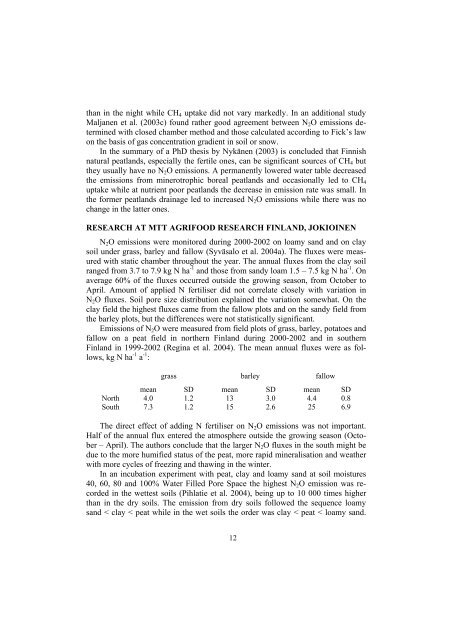soil - Lublin
soil - Lublin
soil - Lublin
You also want an ePaper? Increase the reach of your titles
YUMPU automatically turns print PDFs into web optimized ePapers that Google loves.
than in the night while CH 4 uptake did not vary markedly. In an additional study<br />
Maljanen et al. (2003c) found rather good agreement between N 2 O emissions determined<br />
with closed chamber method and those calculated according to Fick’s law<br />
on the basis of gas concentration gradient in <strong>soil</strong> or snow.<br />
In the summary of a PhD thesis by Nykänen (2003) is concluded that Finnish<br />
natural peatlands, especially the fertile ones, can be significant sources of CH 4 but<br />
they usually have no N 2 O emissions. A permanently lowered water table decreased<br />
the emissions from minerotrophic boreal peatlands and occasionally led to CH 4<br />
uptake while at nutrient poor peatlands the decrease in emission rate was small. In<br />
the former peatlands drainage led to increased N 2 O emissions while there was no<br />
change in the latter ones.<br />
RESEARCH AT MTT AGRIFOOD RESEARCH FINLAND, JOKIOINEN<br />
N 2 O emissions were monitored during 2000-2002 on loamy sand and on clay<br />
<strong>soil</strong> under grass, barley and fallow (Syväsalo et al. 2004a). The fluxes were measured<br />
with static chamber throughout the year. The annual fluxes from the clay <strong>soil</strong><br />
ranged from 3.7 to 7.9 kg N ha -1 and those from sandy loam 1.5 – 7.5 kg N ha -1 . On<br />
average 60% of the fluxes occurred outside the growing season, from October to<br />
April. Amount of applied N fertiliser did not correlate closely with variation in<br />
N 2 O fluxes. Soil pore size distribution explained the variation somewhat. On the<br />
clay field the highest fluxes came from the fallow plots and on the sandy field from<br />
the barley plots, but the differences were not statistically significant.<br />
Emissions of N 2 O were measured from field plots of grass, barley, potatoes and<br />
fallow on a peat field in northern Finland during 2000-2002 and in southern<br />
Finland in 1999-2002 (Regina et al. 2004). The mean annual fluxes were as follows,<br />
kg N ha -1 a -1 :<br />
grass barley fallow<br />
mean SD mean SD mean SD<br />
North 4.0 1.2 13 3.0 4.4 0.8<br />
South 7.3 1.2 15 2.6 25 6.9<br />
The direct effect of adding N fertiliser on N 2 O emissions was not important.<br />
Half of the annual flux entered the atmosphere outside the growing season (October<br />
– April). The authors conclude that the larger N 2 O fluxes in the south might be<br />
due to the more humified status of the peat, more rapid mineralisation and weather<br />
with more cycles of freezing and thawing in the winter.<br />
In an incubation experiment with peat, clay and loamy sand at <strong>soil</strong> moistures<br />
40, 60, 80 and 100% Water Filled Pore Space the highest N 2 O emission was recorded<br />
in the wettest <strong>soil</strong>s (Pihlatie et al. 2004), being up to 10 000 times higher<br />
than in the dry <strong>soil</strong>s. The emission from dry <strong>soil</strong>s followed the sequence loamy<br />
sand < clay < peat while in the wet <strong>soil</strong>s the order was clay < peat < loamy sand.<br />
12

















